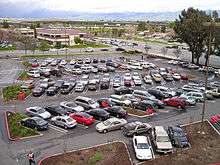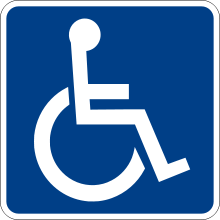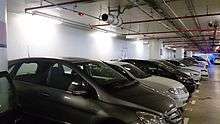Parking lot
A parking lot (Australian and British English: car park), also known as a car lot, is a cleared area that is intended for parking vehicles. Usually, the term refers to a dedicated area that has been provided with a durable or semi-durable surface. In most countries where cars are the dominant mode of transportation, parking lots are a feature of every city and suburban area. Shopping malls, sports stadiums, megachurches and similar venues often feature parking lots of immense area.
Parking lots tend to be sources of water pollution because of their extensive impervious surfaces. Most existing lots have limited or no facilities to control runoff. Many areas today also require minimum landscaping in parking lots, which means that their paved surfaces contribute to heat islands. Many municipalities require a minimum number of parking spaces, depending on the floor area in a store or the number of bedrooms in an apartment complex. In the United States, each state's Department of Transportation sets the proper ratio for disabled spaces for private business and public parking lots. Various forms of technology are used to charge motorists for the use of a parking lot. Modern parking lots use a variety of technologies to help motorists find unoccupied parking spaces, retrieve their vehicles, and improve their experience.
Environmental considerations
Water pollution


Parking lots tend to be sources of water pollution because of their extensive impervious surfaces. Virtually all of the rain (minus evaporation) that falls becomes urban runoff. To avoid flooding and unsafe driving conditions, the lots are built to effectively channel and collect runoff.[1] Parking lots, along with roads, are often the principal source of water pollution in urban areas.[2]
Motor vehicles are a constant source of pollutants, the most significant being gasoline, motor oil, polycyclic aromatic hydrocarbons (PAHs), and heavy metals. (PAHs are found in combustion byproducts of gasoline, as well as in asphalt and coal tar-based sealants used to maintain parking lots.) Many parking lots are also significant sources of trash which ends up in waterways.[3]
Treatment of pollution : Traditionally, the runoff has been shunted directly into storm sewers, streams, dry wells or even sanitary sewers. However, most larger municipalities now require construction of stormwater management facilities for new lots. Typical facilities include retention basins, infiltration basins and percolation trenches.[4] Some newer designs include bioretention systems, which use plants more extensively to absorb and filter pollutants. However, most existing lots have limited or no facilities to control runoff.
Alternative paving materials : An alternative solution today is to use permeable paving surfaces, such as brick, pervious concrete, stone, special paving blocks, or tire-tread woven mats. These materials allow rain to soak into the ground through the spaces inherent in the parking lot surface. The ground then may become contaminated in the surface of the parking lot park, but this tends to stay in a small area of ground, which effectively filters water before it seeps away. This can however create problems if contaminants seep into groundwater, especially where there is groundwater abstraction 'downstream' for potable water supply.

Landscaping
Many areas today also require minimum landscaping in parking lots. This usually principally means the planting of trees to provide shade. Customers have long preferred shaded parking spaces in the summer, but parking lot providers have long been antagonistic to planting trees because of the extra cost of cleaning the parking lots.
Paved surfaces contribute to heat islands in two ways. The first is through excessive accumulation of heat. Dark materials and the enclosed canyons created by city buildings trap more of the sun's energy. The reflection rate of paving compared to natural surfaces is important as higher reflectance means cooler temperatures. Black pavements, the hottest, have solar reflectances of 5 to 10 percent. Lighter pavements have solar reflectance rates of 25 percent or higher. Reflectance values for soils and various types of vegetation range from 5 to 45 percent. The second cause of heat islands is the low moisture content of paving and building materials. Such materials are watertight, so no moisture is available to dissipate the sun's heat through evaporation.[5]
Land usage
A parking lot needs fairly large space, around 25 square meters, or 270 square feet per parking spot. This means that lots usually need more land area than for corresponding buildings for offices or shops if most employees and visitors arrive by car. This means covering large areas with asphalt.
Services
Some lots have charging stations for battery vehicles. Some regions with especially cold winters provide electricity at most parking spots for engine block heaters, as antifreeze may be inadequate to prevent freezing.
Parking minimums

Many municipalities require a minimum number of parking spaces, depending on the floor area in a store or the number of bedrooms in an apartment complex. Parking minimums are also set for parallel, pull-in, or diagonal parking, depending on what types of vehicles are allowed to park in the lot or a particular section of it. Parking minimums initially took hold in the middle of the last century, as a way to ensure that traffic to new developments wouldn't use up existing spaces.[6]
Due to a recent trend towards more livable and walkable communities, parking minimums have been criticized by both livable streets advocates[7] and developers alike. For a time, the British government recommended that local councils should establish maximum parking standards[8] to discourage car use. American cities such as the District of Columbia are now re-thinking parking minimums as a way to add more housing for residents while encouraging the use of public transit.[9]
Big cars are often to large to fit properly in the assigned parking lots, creating issues with entering or leaving the car or blocking adjacent parking lots.
Parking lots designed specifically for bike parking are also becoming more prevalent in response to increased environmental and health consciousness. These may include bicycle parking racks and locks, as well as more modern technologies for security and convenience.[10] For instance, one bicycle parking lot in Tokyo includes modern features such as an automated parking system.[11]
Legal issues

Sweden and Denmark

In Sweden and Denmark, there are legally two types of car parking, either on streets and roads, or on private land. A parking violation on streets is a traffic crime, resulting in fines. A parking violation on private land (also if owned by the city) is a contract violation and gives additional parking fee (Swedish: kontrollavgift = check fee). The difference is small for the car owner and the owner is always responsible.
United Kingdom
The United Kingdom has two types of car parking: either on public or on private land. The difference is that the police will investigate any reported accident on public land but have no legal obligation and will not do so on private land. Public road is defined by the Road Traffic Act 1972 and (Amendment) Regulations 1988 S.I. 1988/1036[12] as: "Road", in relation to England and Wales, means any highway and any other road to which the public has access, and includes bridges over which a road passes. There is also a House of Lords judgment on this matter.[13]
Civil enforcement officers enforce parking restrictions on public, council-run car parks. These include failure to purchase a ticket as payment (if available)/not parking in a marked bay/other offenses.
United States
In the United States, each state's Department of Transportation sets the proper ratio for disabled spaces for private business and public parking lots. Certain circumstances may demand more designated spaces. These reserved spaces are mandated by the Americans with Disabilities Act Accessibility Guidelines.[14]
Those in possession of the proper ID tags or license plates are also free from parking violation tickets for running over their metered time or parking in an inappropriate place, as some disabilities may prohibit the use of regular spaces. Illegally parking in a disabled parking space or fraudulent use of another person's permit is heavily fined.
Payment

Various forms of technology are used to charge motorists for the use of a parking lot.
Boom gates are used in many parking lots. A customer arrives to the entry ticket machine by vehicle, presses the ticket request push button, takes a ticket - which raises the barrier - and enters the parking lot. To exit the lot, the customer presents the ticket to a cashier in a booth at the exit and tenders payment, after which the cashier opens the boom gate.
In 1954, the first automated parking lots were built where, for a monthly fee, a driver with a magnetic key card could enter and exit the parking lot by raising and lowering the boom.[15]
A more modern system uses automatic pay stations, where the driver presents the ticket and pays the fee required before returning to their car, then drives to the exit terminal and presents the ticket. If the ticket has not been paid for, the boom barrier will not raise, which will force the customer to either press the intercom and speak to a staff member, or reverse out to pay at the pay station or cashier booth.
At the parking lots of some major airports in the United States, a driver can choose to swipe a credit card at the entry ticket dispenser instead of taking a ticket. When the driver swipes the same credit card at the exit terminal upon leaving the lot, the applicable parking fee is automatically calculated and charged to the credit card used.
In some parking lots, drivers present their tickets to and pay the cashiers at a separate cashier's office or counter (which are often located elsewhere from the entrances and exits of carparks). Such cashier's offices are called shroff offices or simply shroff in some parking lots in Hong Kong and other parts of East Asia influenced by the Hong Kong usage. If a ticket has not been paid, the barrier will not raise. In recent years, cashiers and shroff officers have often been replaced with automated machines. Another variant of payment has motorists paying an attendant on entry to the lot, with the way out guarded by a one-way spike strip that will only allow cars to exit.
Parking meters can also be used, with motorists paying in advance for the time required for the bay they are parked in. Pango (a play on "pay and go"[16]), a company founded in Israel in 2007, created a mobile app that allows users to both find and pay for available metered parking; the app can also be used to pay for garage parking.[16] Users' accounts are linked to a payment method, and the system remembers where a vehicle is parked and allows users to share a parking session with Facebook friends. Users may also, for a nominal monthly fee per registered car, subscribe to reminders that text alerts shortly before metered time expires,[17] and in some municipalities, users may buy additional metered time via cellphone. Philadelphia, encourages parking space turnover by charging escalating parking fees when metered time is added.[18][19] The PayByPhone app offers similar features and benefits; a press release notes: "The technology also will warn motorists when their time is about to expire via e-mail or text messages, and allow them to pay for additional time easily and quickly, up to the posted time limit. Interested motorists can sign up for the service for free on the PayByPhone website and register their license plate numbers and credit card information on encrypted servers and download the PayByPhone app."[20][21] Another app, Streetline, whose primary purpose is to help motorists find open parking spots using their smartphones, includes a timer, so users can get back to a parking meter before it expires, and a filter that lets users choose between on-street and off-street parking spaces; it also connects to the phone's camera so a user can take a photograph of their car.[22]
Other lots operate on a pay and display system, where a ticket is purchased from a ticket machine and then placed on the dashboard of the car. Parking enforcement officers patrol the lot to ensure compliance with the requirement.
Similar to this is the system where the parking is paid by the mobile phone by sending an SMS message which contains the license plate number. In this case, the virtual cashier books the car and the time when the message is sent, and later a new SMS message must be sent whenever the time is due. The actual payment is then made via the mobile phone bill.
Since 1978 in the United Kingdom, it has been possible to pre-book parking with specialist companies, such as BCP. This is prevalent at all airports, major ports and cities.
Technology

Modern parking lots use a variety of technologies to help motorists find unoccupied parking spaces using parking guidance and information system, retrieve their vehicles, and improve their experience. This includes adaptive lighting, sensors, indoor positioning system (IPS) and mobile payment options. The Santa Monica Place shopping mall in California has cameras on each stall that can help count the lot occupancy and find lost cars.[23]
In outdoor parking lots, GPS can be used to remember the location of a vehicle (some apps saves location automatically when turning off the car when a smartphone breaks communication with a vehicle's Bluetooth connection). In indoor parking lots, one option is to record one's Wi-Fi signature (signal strengths observed for several detectable access points) to remember the location of a vehicle.[24]
Online booking technology service providers have been created to help drivers find long-term parking in an automated manner, while also providing significant savings for those who book parking spaces ahead of time. They use real-time inventory management checking technology to display parking lots with availability, sorted by price and distance from the airport.
There are mobile apps providing services for the reservation of longterm parking lot spaces similar to online or aggregate parking facility booking services. Some longterm parking mobile apps also have turn-by-turn maps to locate the parking lot, notably US and UK based ParkJockey.
See also
| Wikimedia Commons has media related to Carpark. |
- Automated parking system
- Automatic vehicle location
- Charging station
- Indoor positioning system (IPS)
- Automatic number plate recognition (ANPR)
- Multi-storey car park
- Park and ride
- British Parking Association
- Road surface marking
- Parking meter
- Parking space
- Radio-frequency identification (RFID)
- Vehicle location data
References
- ↑ Schueler, Thomas R. "The Importance of Imperviousness". Reprinted in The Practice of Watershed Protection. 2000. Center for Watershed Protection. Ellicott City, MD.
- ↑ United States. National Research Council. Washington, DC. "Urban Stormwater Management in the United States". October 15, 2008. p.5
- ↑ G. Allen Burton, Jr., Robert Pitt (2001). Stormwater Effects Handbook: A Toolbox for Watershed Managers, Scientists, and Engineers. New York: CRC/Lewis Publishers. ISBN 0-87371-924-7. Chapter 2.
- ↑ California Stormwater Quality Association. Menlo Park, CA. "Stormwater Best Management Practice (BMP) Handbooks". Archived January 18, 2008, at the Wayback Machine. 2003.
- ↑ Wolf, Kathleen (2004). Trees, Parking and Green Law: Strategies for Sustainability (PDF). Georgia: USDA Forest Service, Southern Region Georgia Forestry Commission. p. 8.
- ↑ Slate. There's No Such Thing as Free Parking. by Tom Vanderbilt
- ↑ Fried, Ben (20 August 2008). "How to Fix Off-Street Parking Policy, Before It's Too Late". StreetsBlog NYC. Retrieved 27 March 2015.
- ↑ Communities.gov.uk
- ↑ http://www.washingtoncitypaper.com/blogs/housingcomplex/2013/03/20/out-damned-spot-how-d-c-s-onerous-parking-requirements-slow-development/
- ↑ "The Guide to Parking Lots". Discount Park & Ride. 9 January 2015. Retrieved 27 March 2015.
- ↑ "Invisible Bicycles: Tokyo's High-Tech Underground Bike Parking". Web Urbanist. 26 March 2015. Retrieved 27 March 2015.
- ↑ Road Traffic Act 1988 (c. 52)
- ↑ House of Lords - Clark (A.P.) and Others v. Kato, Smith and General Accident Fire & Life Assurance Corporation PLC
Cutter v. Eagle Star Insurance Company - ↑ ADA Accessibility Guidelines Parking and Passenger Loading Zones
- ↑ "Key Card Inserted In Slot Opens Gate At Automated Parking Lot". Popular Science. August 1954. p. 94. (mid page)
- 1 2 Furman, Phyllis (August 6, 2013). "Parking app Pango making tracks in NYC, adding 20 more garages over next few weeks (App that speeds up pick-ups and payments spreading to 110 Manhattan garages by year-end)". New York Daily News. Retrieved January 17, 2016.
- ↑ Staff Writer (November 4, 2014). "Mt. Vernon Launches Pango Mobile Payments for Parking on November 5". Mount Vernon Inquirer.
- ↑ Philadelphia Parking Authority Staff (May 21, 2015). "Pango Mobile Parking App Coming to Philadelphia". The PPA Blog.
- ↑ "PANGO Mobile Parking". Parking Network.
- ↑ "NYC Launch: Mayor Bloomberg Announces the Launch of PayByPhone in New York City". PayByPhone.com. 2013.
- ↑ Mandell, Nina (April 9, 2013). "PayByPhone App Finally Available To Make Parking Easier In New York City (Big Apple drivers are getting a little help from the Department of Transportation)". FastCompany.
- ↑ Motavalli, Jim (October 11, 2012). "New York Times contributor blogs about interesting ways of getting around. Streetline app aims to end the hunt for a parking space". Mother Nature Network.
- ↑ Martha Groves (January 23, 2011). "Servant or snoop in the parking garage?". Los Angeles Times. Retrieved August 29, 2014.
- ↑ Joshua Correa, Ed Katz, Patricia Collins, Martin Griss (November 2008). "Room-Level Wi-Fi Location Tracking" (pdf). Carnegie Mellon Silicon Valley MRC-TR-2008-02.